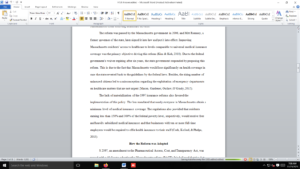Healthcare Reform Policy Analysis
This assignment is an analysis of local, state, or federal health policy.
- Select a state health policy reform innovation
- Discuss the rationale for the policy, how it was adopted (e.g., federal waivers, passage by state legislature), the funding structure, and (to the extent statistical data are available) its impact. ethical outcome based on evidence.
- Examples of state innovations include Maryland’s hospital rate setting, Vermont’s single payer system, and Massachusetts’ health reforms
Submission Requirements:
- The paper is to be clear and concise and students will lose points for improper grammar, punctuation and misspelling.
- The paper is to be formatted per current APA style, 5-7 pages in length, excluding the title, abstract and references page.
- Incorporate a minimum of 5 current (published within last five years) scholarly journal articles or primary legal sources (statutes, court opinions) within your work.
- Journal articles and books should be referenced according to current APA style
******See attached the book for this course******
Requirements: 5-7 pages in length, excluding the title, abstract and references page
Answer preview
This is due to the fact that Massachusetts would lose significantly on health coverage in case the state reverted back to the guidelines by the federal laws. Besides, the rising number of uninsured citizens led to a misconception regarding the exploitation of emergency departments on healthcare matters that are not urgent (Mason, Gardener, Outlaw, O’Grady, 2015).
The lack of materialization of the 1997 insurance reforms also favored the implementation of this policy. The law mandated that nearly everyone in Massachusetts obtain a minimum level of medical insurance coverage. The regulations also provided that residents earning less than 150% and 300% of the federal poverty level, respectively, would receive free and heavily subsidized medical insurance and that businesses with ten or more full-time employees would be required to offer health insurance to their staff (Cseh, Koford, & Phelps, 2015).
[1832 Words]

Healthcare Reform Policy Analysis

